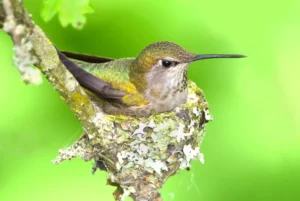A hummingbird nest is a small, cup-shaped nest made of plant material and spider webs, often lined with soft materials such as mosses and feathers. The female hummingbird builds the nest alone, using her beak and feet to weave plant material together.
The average hummingbird nest is about the size of a thimble but can vary depending on the species of hummingbird. There are some tips:
- Find a suitable location for the nest
- A hummingbird nest is typically built in a tree, on a branch that is close to the trunk
- The location should be safe from predators and protected from the elements
- Gather materials for the nest
- Hummingbirds use spider webs and plant down to build their nests
- They will also incorporate bits of leaves, twigs, and feathers into the structure
- Build the base of the nest by weaving together spider webs and planting down
- The base should be about 3 inches (7.62 cm) in diameter and 1 inch (2.54 cm) deep
- Add pieces of leaves, twigs, and feathers to the base of the nest until it is well-insulated and has a soft lining inside
- Finish building the nest by shaping it into a cup shape with smooth sides
- The opening of the nest should be about 2 inches (5.08 cm) wide
